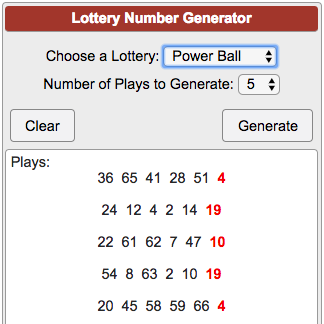Powerball Hot Numbers

Hot and cold lottery numbers. Choose the lottery and the period you would like to find out the hot and cold numbers for. It's not always easy to come up with your Powerball numbers. If you need help choosing yours and don't know where to start, our Lucky Numbers tool is the perfect option. It will generate a full set of numbers for your ticket using our top-secret random algorithm and print the results on screen. Generate as many numbers as you need for free. Not all Powerball numbers are created equal. Some numbers are hotter than others. The Powerball jackpot for the Wednesday, January 13, 2016 drawing has grown to a record $1.5 billion.




Powerball Hot Numbers Generator
Related Pages
Annuity Cashflow Calculator - Shows yearly annuity payments and tax implications
Probability of Winning - Shows chances of multiple winners or why jackpots are not always won
( New ) Jackpot Investment Calculator - Compares 30 year cashflow investment of the Annuity against the lump sum Cash Option Jackpot (side by side)
Many people believe that certain numbers are drawn more frequntly than others, and that others are selected less often. These are often referred to as: Hot and Cold numbers. In order to help players identify these, many lotteries provide Frequency Tables.
However, when trying to interpret this information, players are faced with the several problems and questions. First, does this data indicate that these numbers perform better or worse over the long run? Or, is this simply a function of short term trends? Second, the format of certain games has changed over time. Balls are added and deleted. How can we normalize this information to account for the fact that certain balls have been present longer that others? Third, is this statistical data meaningful?
To help answer these questions, we have prepared this analysis which contains four panels. Window PB-1 in the lower left displays a tabular analysis of the most common white and Power lottery balls. The total occurances of each ball is shown for: 3 Month, 6 Month, 1 Year, 2 Year, and All Time terms. The cells are color coded to illustrate numbers that are: Cold (Blue), Cool (Light Blue), Warm (Light Red), and Hot (Red). The non-shaded numbers are neutral.
Hotness and Coldness is assigned utilizing a weighted statistical analysis which involves first determining the expected number of occurances, and then calculating the actual observed deviations. This data is shown in Window PB-2. The graph displayed in Window PB-3 shows a normal probability distribution. This is an important concept of randomness because we know that there will be an expected amount of noise (or deviation) whenever such events are measured.
Lastly, Window PB-4 puts it all together by summarizing how often the lottery jackpots would be won if a player limits his playing numbers to certain subsets: Hot, Cold, Hot + Cold, Neutral, and Neutral + Hot. These tables only show the highest prizes that would be won, not the sum of all the prizes.
Annuity Cashflow Calculator - Shows yearly annuity payments and tax implications
Probability of Winning - Shows chances of multiple winners or why jackpots are not always won
( New ) Jackpot Investment Calculator - Compares 30 year cashflow investment of the Annuity against the lump sum Cash Option Jackpot (side by side)
Many people believe that certain numbers are drawn more frequntly than others, and that others are selected less often. These are often referred to as: Hot and Cold numbers. In order to help players identify these, many lotteries provide Frequency Tables.
However, when trying to interpret this information, players are faced with the several problems and questions. First, does this data indicate that these numbers perform better or worse over the long run? Or, is this simply a function of short term trends? Second, the format of certain games has changed over time. Balls are added and deleted. How can we normalize this information to account for the fact that certain balls have been present longer that others? Third, is this statistical data meaningful?
To help answer these questions, we have prepared this analysis which contains four panels. Window PB-1 in the lower left displays a tabular analysis of the most common white and Power lottery balls. The total occurances of each ball is shown for: 3 Month, 6 Month, 1 Year, 2 Year, and All Time terms. The cells are color coded to illustrate numbers that are: Cold (Blue), Cool (Light Blue), Warm (Light Red), and Hot (Red). The non-shaded numbers are neutral.
Hotness and Coldness is assigned utilizing a weighted statistical analysis which involves first determining the expected number of occurances, and then calculating the actual observed deviations. This data is shown in Window PB-2. The graph displayed in Window PB-3 shows a normal probability distribution. This is an important concept of randomness because we know that there will be an expected amount of noise (or deviation) whenever such events are measured.
Lastly, Window PB-4 puts it all together by summarizing how often the lottery jackpots would be won if a player limits his playing numbers to certain subsets: Hot, Cold, Hot + Cold, Neutral, and Neutral + Hot. These tables only show the highest prizes that would be won, not the sum of all the prizes.